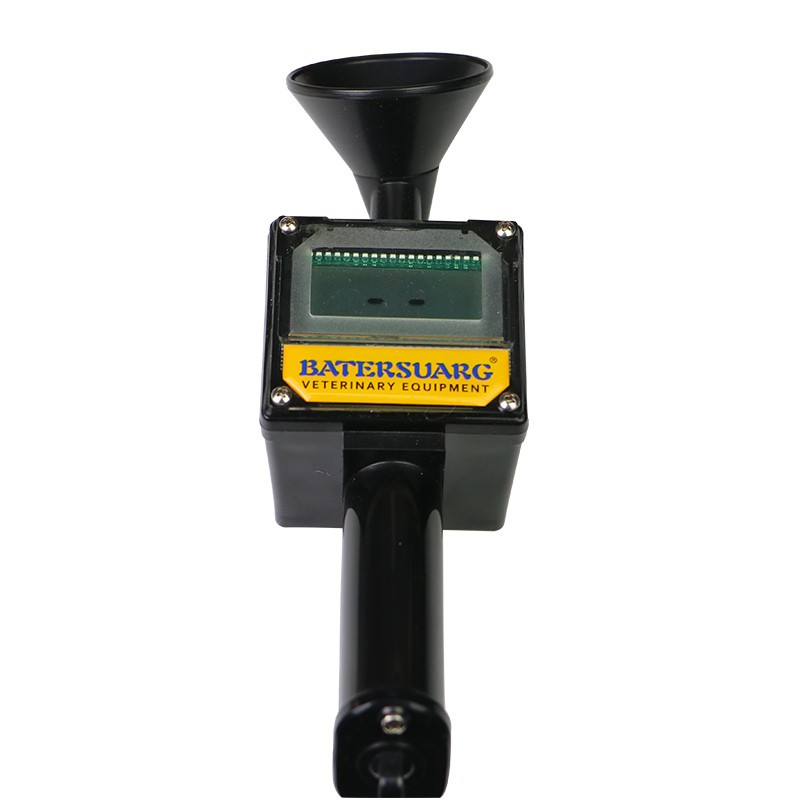CTM Cow Mastitis(Latent) Detector
- Product Item : CTM
- Category: Instrument
- Display:LCD display 4 x 3 digits
- Estimated working time:22Hours
- Dimensions: 25.0 x 7.0 x 9.0 cm
- Weight:265 g (with battery)
Product advantage
-1. The machine body is waterproof, the switch is waterproof, and the insulated handle;
-2. Large digital display screen: automatically display numbers, the data is intuitive and accurate;
-3. Removable replacement Battery: Display "LB", please replace the battery with new one.
-4. Anti-collision, chemical resistance, easy to clean.
How to judge the data result ?
The detector has a wide data range for interpreting monitoring results. Changes in readings indicate the degree of infection, but do not simply judge the presence or absence of mastitis with a certain data.
-1.Readings above 300 units:
The quality of the milk is very good, and the cow is healthy (in the case of mastitis infection), the probability of mastitis is small.
-2.Reading between 300 and 250 readings:
As the reading becomes smaller, the likelihood of contracting mastitis increases.
-3.Readings below 250 units:
As spastic mastitis ly shifts to dominant mastitis, infections become more and more serious, and from a somatic cell perspective, cells have increased from less than 1 million to millions.
How to Correct understanding of readings
-1.It is not possible to determine whether or not to take treatment based on the level of a single breast reading. Need to raise a comprehensive analysis, you can also consult a professional. We recommend that when the reading is less than 280, the breast needs to be checked regularly, and if the reading is ly reduced, the degree of infection is increasing, or mechanical damage has occurred.
-2.Changes in the readings of the four breasts of the cow can help you determine if your breasts are healthy. For example, if the average of four breast readings is 300-340, then a breast with a reading below 300 indicates that treatment is needed. If the average is 370-380, then the breast with a reading below 330 has a more severe infection.
-3.It makes sense to compare the differences in the four breast readings of a single cow.
-4. If the cow is already in the stage of dominant mastitis, the reading has no reference. At this time, the reading will return to more than 300, because the cows that have been seriously polluted have undergone substantial changes.
-5. Frequent testing is of course beneficial for detecting mastitis, but for large herds, it is sufficient to establish regular tests and create data files. Finding and monitoring cows that receive threats of infection through data archives is a very necessary task.
-6. If the cow's test data is generally below 300 in the herd, the milking equipment should be inspected. The general reading is less than 300 units, indicating that there may be excessive milking or acidosis.
7. There is a correlation between the readings of the recessive mastitis detector and the somatic cells, but the mastitis detector cannot be used as a somatic cell base.
Detection Steps
-1. Press the switch to wait for two horizontal lines on the display
-2. Place the sampling cup under the nipple 1 and squeeze the milk directly into the sampling cup. The milk should be full of cups, at least not below the tick mark.
-3. After 2 seconds, press the switch key again to start the test, and the screen displays the test result
-4. Pour the tested milk into an empty bucket (slightly shake and remove the residual liquid from the sampling cup).
-5. Repeat the above steps to detect nipples 2, 3 and 4.
-6. Dip the sample cup into clean water and turn it to wash away the residual milk.
Note: When a breast is detected with recessive mastitis, the sample cup should be thoroughly cleaned to prevent residual milk from affecting the next test.
Product acessories
-1. CTM mastitis detector;
-2. 1 x 9V 6F-22 type battery;
-3. Reusable transport packaging (made of plastic)
-4. Manual.


CATEGORIES
LATEST NEWS
CONTACT US
Mobile:+86-18612182039
Tel:+86-029-85274126
Whatsapp:+8618612182039
Email:info@watarbio.com
Add:No. 12, Hongzhuan South Road, Yanta District, Xi’an 710061, China










